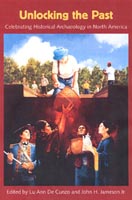Native and “Newcomer”: Battle of Little Bighorn
Richard A. Fox

Archaeologists excavating in foreground; Custer Hill with granite memorial in background.
Archaeologists can also learn how land battles played out and, by incorporating the voices of minorities, we begin to understand better the clashes between cultures. One of the most prominent clashes between cultures in North American history--Custer's battle--took place on 25 June 1876 in what is now Montana. There, along Little Big Horn River, the Seventh U. S. Cavalry, led by Lt. Col. George Custer, met defeat at the hands of the Sioux and Northern Cheyenne. Much has been said and written about the battle of Little Big Horn River, but our histories of this conflict largely exclude perspectives of the native victors. Now, historical archaeology has challenged that bias and revised our understanding of what happened there.
Over a century after the battle, we began digging at the site, now the Little Big Horn Battlefield National Monument, a U. S. National Park Service property. Our team investigated the entire battlefield. Dedicated volunteers systematically surveyed the terrain using state-of-the-art metal detectors, while others carefully excavated test units. But as we planned the project, we weren’t sure if much remained. Then came our first day in the field, the day that our uncertainty vanished, the day we knew our efforts would be rewarded. That day we ended up with over a hundred artifacts. And our excitement did not end there. Day after day the artifacts of battle flowed in, until we had unearthed thousands.
Prior to our work at Little Big Horn the general consensus was that battlefields held little interpretive value. Now that has changed, as David Starbuck has said earlier in this chapter. Historical archaeologists are at work at many battlefields, often incorporating strategies and methods pioneered at the Little Big Horn. Doug Scott, my NPS counterpart on the Little Big Horn project, has worked with Southern Cheyenne, Southern Arapaho, Northern Cheyenne, and Northern Arapaho to relocate the site of the 1864 Sand Creek Massacre in Colorado, in which one hundred fifty Cheyenne and Arapaho elders, women, and children died at the hands of American soldiers. As far away as South Africa, our work serves as a model for on-going investigations at Islandwana, where Zulu natives fought British colonialists just three years after the Little Big Horn. Interests in American battlefields have also emerged. One project focuses on the Fallen Timbers battlefield, where, in an early (1794) conflict with Native Americans, Shawnee and Michikinikwa warriors defeated General Anthony Wayne. Historical archaeologists have also illuminated our understanding of the struggle at Palo Alto, Texas, a U.S.-Mexican War battle (1846). And the same can be said for projects at Civil War battlefields, including Antietam (1862) in Maryland.
Battlefield historical archaeology is here to stay. The stir in interest
is perhaps no better exemplified than in the National Park Service’s
American Battlefield Protection Program, which recognizes the importance
of battlefields in American history, and the major role archaeology has
in interpreting them.
